Right tires go beyond all-wheel-drive security
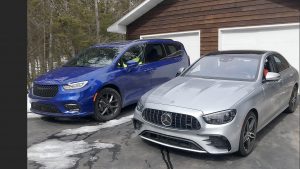
Both 2021 Pacifica, left, and Mercedes AMG E53 sedan have all-wheel-drive available, but the tires make huge difference on ice.
By John Gilbert
How many people do you know who have had to call Triple-A to get their car extricated from a bad situation? A lot, I imagine. But how about from their own driveway? Now we’re getting somewhere, he added, raising his hand at his own question.
When springtime comes to the Great White North, we all shift into a celebratory mood, having conquered another round of winter for another year — albeit the weirdest year of our lives. But sometimes we, and the auto companies we know and love, get outflanked when they take Mother Nature for granted.
March arrived like a lamb in Duluth, Minnesota, as we broke a hundred-and-some-year-old record for the warmest temperature on that date, reaching 55 degrees. The two agencies that bring me new vehicles to test drive brought me a succession of three cars. One brought a Mercedes AMG E53 Sedan, and a new Chrysler Pacifica, the Limited version van with an S package. They both, by chance, had all-wheel drive.
The other delivery outfit brought me a new Mazda3, a very neat subcompact with the company’s new 2.5-liter turbocharged engine and, believe it or not, all-wheel drive. I joked to my wife, Joan, that here we were, breaking temperature records for mild weather and we have three AWD cars.
I was going out to catch a Division III women’s college hockey playoff game, and I decided to drive the Mazda3. I scoffed at the warning of possible snow, but wanted to keep the Mercedes pristine, and the stunning blue Pacifica also out of any weather risk. It did start snowing, gigantic flakes, and they came harder and harder, causing me to leave the game halfway through. The Mazda3 and I slid around a disturbing amount in the deepening and unplowed snow, but I made it home up our rural hill on the North Shore of Lake Superior, and drove in the 100 yards of my straight driveway, parking at an odd angle to allow our incredible neighbors space to work their plowing magic.
Next morning, we were buried under 7.5 inches of the heaviest, cement-like snow I’ve ever shoveled. And shoveled. And shoveled. Joan had to get to work, and she’s an excellent all-weather driver, but I suggested I’d drive her the 10 miles to work, and pick her up. My choice was the Pacifica, being higher off the ground, and a good opportunity to test its new limited-slip all-wheel-drive system, which uncouples the rear axle when the computer tells it there’s no risk of losing traction.
I backed around the two parked vehicles and got the Pacifica aimed to back straight out of the driveway, and as I started, I figured I’d better get some momentum going for the highway snowplow’s inconvenient pile at the road. I hit the gas, and in an instant, the Pacifica shot sideways — 6 feet to the right and just enough to put the right wheels over the edge of the asphalt lip of the driveway, nestled down into the snow. I was amazed at how the limited-slip concept was overwhelmed by my unlimited-slip snow-covering, resulting in the Pacifica possibly spending the rest of the winter at our home.
I already knew the Mazda’s Bridgestone Turanza tires were not the grippiest, so I said we should take the Mercedes. Its $82,370 sticker priced was no assurance of passing this severe test! We climbed aboard and I set the mode switch to “slippery,” got it onto the straight part of the driveway and I built the speed gradually as we kept moving, churning smoothly to the end of the driveway and through the plowed pile. I turned left to head down the hill, and we drove to Joan’s workplace without ever even spinning a tire.
After returning to our rural home, i called AAA, which was another humbling experience. A pleasant fellow told me his office was in Michigan. As I explained my predicament, he already had our home pinpointed on his computer, and as he was saying a wrecker driver would be dispatched as soon as possible, I felt my iPhone 11 vibrate. Figuring it might be Joan, I was surprised that it was Tony, from Two Harbors Towing and he said he’d arrive within 15 minutes. I was impressed. The driver called before I was through phoning in my need to Triple-A!
He grumbled a bit, three or four times, about our driveway being unplowed, and I told him we have two neighbors who both plow us out, and we are so thankful for that we are not in position to suggest a schedule. So he shrugged and went after it. Because of the new AWD system perhaps, or the lack of a trailer hitch despite a 3,600 tow capacity, there was no place to connect his cable to the rear. So he drove around the stuck Pacifica, turned up the slight grade toward our garage, and hooked the cable under the front. By throwing a switch, his wrecker pulled the Pacifica up and over the edge and back onto our driveway.
I aimed the Pacifica at backing out the driveway, now that there were a couple of tracks through the 7.5-inch snowfall, and I made it with only moderate slithering, up and over the now-battered snowplow ridge at the road. Tony was worried about getting his tow truck stuck, but he, too, made it out. I thanked him and he left, and as he drove down our hill, sure enough, our neighbor Eric drove down his driveway in his trusty F-350 Ford diesel, which he uses to tow a boat or camping trailer, and also for what he calls fun — to clear out driveway.
It got back up into the 40s the next few days, and most of that enormous snowfall went away, and we were able to better test the Pacifica, delaying our time with the very impressive Mazda3, but since the Pacifica and the Mercedes were both being picked up a couple days earlier, we devoted our drive time to them.
First, however, the object lessons for the week came on all those stylish alloy wheels. Often people buy a car, and several months later if it slips on ice they declare that the car is no good in the winter. In reality, of course, your only connection with the road surface is your tires. In the not-to-distant past, my clear preference was for Nokian tires, because they had great traction no matter how cold it was. The tread design is effective, designed by cold-weather experts in Finland, and the tread compound is comprehensively designed to maintain flexibility no matter how cold it gets. Going above the Arctic circle to test in Finland, and driving in Northern Minnesota, are greatly similar, and I always check what kind of tires are on my test cars.
The Mazda3 had, as I mentioned, Bridgestone Turanzas. Bridgestone makes Blizzaks, the no-compromise ice-driving tires, so they know what they’re doing. But the Turanza, like everything else in the tire business, is a compromise. On the Mazda3, the tires were more prone to spin than stick. If I bought that car — and there are numerous great reasons to consider one — I would quickly invest in top-level winter or all-season tires.
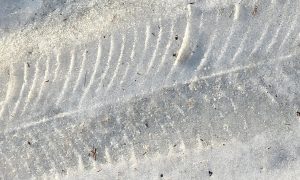
Tread-marks left by Michelin Pilot
Alpin tires on Mercedes E53, after heavy snow failed to cause even one spin.
The Pacifica, with this new scheme of adjusting the two axles based on limited-slip tendencies to spin, should be a real benefit in most driving in most seasons. And it might be very good in Minnesota winters, too, but the Falken Ziex all-season tires were best suited for “almost all-season” duty, rather than Minnesota blizzards.
The Mercedes, with all that power and torque, left a distinctive pattern in the snow, in the melted and refrozen ice, and in the muddy fringes of my driveway. The tires were Michelin Pilot Alpin tires, where, I believe, Alpin is the French version of Alpine. They were excellent on Dulutn’s steep hills and on clear roadways, as well as churning through 7.5 inches of snow to get past that nasty coating of ice underneath.
The Mercedes all-wheel-drive system was impressive too, and you could set the mode to comfort, or sport, or sport-plus, as well as “slippery.” My only remaining question is how well they will last on dry pavement, whether you can leave the Alpins on year-round, or whether you might want to alternate them with summer tires. I found out also that the car came with more high-performance tires, but Mercedes notified Rick Schmidgall at GSchmitz & Associates to install good winter tires before the car went out to media test-drivers.
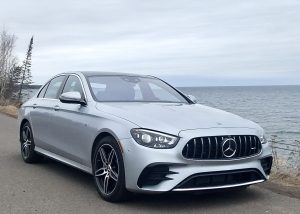
Mercedes turned its AMG branch loose to create the stylish, hot-performing E53, which kept performing the next day, through 7.5 inches of heavy snow.
Jeff Hofslund, who operates Foreign Affairs in Duluth and was the top-selling Nokian dealer in the country a couple years ago, agreed that most tire manufacturers now make a variety of different-purpose tires, and most of their winter tires do a good job on ice and snow. I have tested top all-season tires from Pirelli, Continental and Goodyear that are very good on ice, even against the Blizzak and Nokian. Now I can add the Michelin Pilot Alpin to that group.
The Mercedes is at an interesting crossroads, similar to Cadillac, because their newest cars, and engines, are the best they’ve ever made, but both are hurrying toward electric power, and the smooth AMG-enhanced 3.0-liter inline 6 is EQ-boosted. The 9-speed automatic transmission has steering-wheel paddles to allow manual shifting. On the console, among other switchgear, there is a button that allows you to open the exhaust up for a wonderful sound enhancement, particularly in sport or sport-plus settings.
They were so impressive that I agreed to let Joan do the test-driving the next couple days, knowing I would have to sneak the key fob to get it back.
Nice to have all the comfort and safety elements standard on everything from Stuttgart these days, buttoned into a car that can still toss off its luxury shroud and become a hot-rod screamer. Joan and I held the Mercedes in check and went for a pre-Easter drive from Duluth to Virginia, Mn., where we could visit Canelake’s Candy shop and load up on the small, sweet gifts we can send to our two sons. And, of course, nibble ourselves.
Pamela and Dennis Matson run the third-generation shop and are doing amazing things to restore its soda fountain to nostalgic usage. We were excited about going there with Easter coming up, because the shop where Pamela and her identical-twin sister Patricia Canelake started this venture is in Knife River, Mn., called Great! Lake Candy Shop. They have the best chocolate, caramel and other candies, made on site, but they always have taken a break during winter, from late December until April, so Easter goes by without their candy. The Virginia shop stays open. And busy.
Pamela and Dennis were busy with their staff creating and filling a load of Easter eggs — light and dark chocolate eggs, about 3 inches long, filled with Maple cream, coconut, vanilla, cherry vanilla, Key Lime pie, chocolate, and maybe a couple more that I missed. But I don’t miss much in that shop.
Cruising back to Duluth on Hwy. 53, we watched the computer reading rise to 28 miles per gallon, with the setting on comfort and the exhaust system demurely shut off, and my right foot delicately feathering the gas pedal, when I didn’t have the cruise control engaged.
The next day, we dedicated to driving the Pacifica S Limited, with its potent 3.6-liter V6, operated by a 9-speed as well. Performance and handling were very good, now that the snow had gone south, so to speak, and its cornering and stable attitude were impressive. The utility of the loaded Pacifica makes it a great family hauler, and the test van came with four captain’s chairs and a split bench third-row seat. It’s amazing how much interior room there is inside, with a cavernous and deep area behind the third row.
For hauling stuff, you can use electric switches to fold the third row forward, or recline the backrests, which disappear into the cavernous rear area, while the second-row buckets fold down flat or fold forward and tumble into hidden storage areas in the floor.
The seats are smooth and luxurious black leather, which complemented the Ocean Blue exterior well. With that potent 3.6, the Pacifica can take off swiftly from a stoplight, and help you appreciate how well it handles. It goes, turns and proves its agility. It will handle nearly anything, with the possible exception of backing out of an ice-covered driveway.
At that, it went off with a certain acquiring of style points, and if you mounted great all-season tires like those Michelin Pilot Alpins, or Nokians, you could do all sorts of tricks all winter long, without being tempted to simply make up and blame those slithery tires. I promised that I would not attribute my problems by saying, “It’s just those Falken tires.”


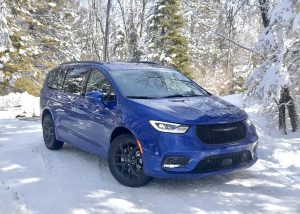
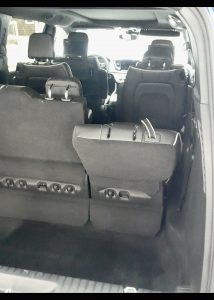
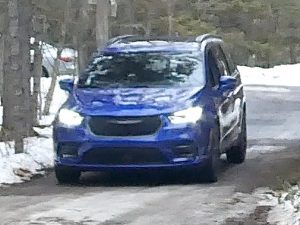
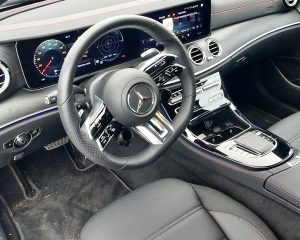
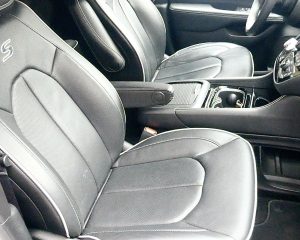
 John Gilbert is a lifetime Minnesotan and career journalist, specializing in cars and sports during and since spending 30 years at the Minneapolis Tribune, now the Star Tribune. More recently, he has continued translating the high-tech world of autos and sharing his passionate insights as a freelance writer/photographer/broadcaster. A member of the prestigious North American Car and Truck of the Year jury since 1993. John can be heard Monday-Friday from 9-11am on 610 KDAL(www.kdal610.com) on the "John Gilbert Show," and writes a column in the Duluth Reader.
John Gilbert is a lifetime Minnesotan and career journalist, specializing in cars and sports during and since spending 30 years at the Minneapolis Tribune, now the Star Tribune. More recently, he has continued translating the high-tech world of autos and sharing his passionate insights as a freelance writer/photographer/broadcaster. A member of the prestigious North American Car and Truck of the Year jury since 1993. John can be heard Monday-Friday from 9-11am on 610 KDAL(www.kdal610.com) on the "John Gilbert Show," and writes a column in the Duluth Reader.